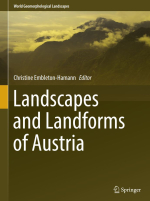Добрый день, Коллеги. Важное сообщение, просьба принять участие. Музей Ферсмана ищет помощь для реставрационных работ в помещении. Подробности по ссылке
Landscapes and landforms of Austria / Ландшафты и формы рельефа Австрии
The landforms of Austria are the direct consequence of a continuous interplay between tectonic and climatic forces that have built, destroyed and reshaped the surface of the most iconic mountain belt on Earth for almost 40 Million years. As such, landforms can only be understood with a thorough geological background. This paper gives an overview of the tectonic evolution, the geological build up and the landscape evolution in the Austrian territory. The tectonic evolution of the rocks forming the major tectonic units of Austria can be traced back to some 500 Million years when they were located at different ancient continents including Gondwana, Avalonia and Laurasia. In the late Palaeozoic, the basement rocks were affected by the Variscan tectonometamorphic event during amalgamation of the supercontinent Pangaea and by a Permian extensional event. The latter is responsible for and was followed by a long-lived phase of thermal subsidence triggering the deposition of the Mesozoic sedimentary pile of the Northern Calcareous Alps. The formation and later subduction of the Neotethys and Penninic oceans began in Triassic and Jurassic times, respectively. The Alpine orogen as we know it today is largely the consequence of the head-on collision between the Adriatic and European plates once subduction had terminated around 40 Ma. The geological build up of Austria includes the Alps and its northern foreland. The foreland is composed of Variscan gneisses in the Bohemian Massif, their Mesozoic cover and Cenozoic sediments in the Molasse Basin. The Alps are made up of tectonic units derived from the European and Adriatic continents and the Neotethys and Penninic oceans that are covered by some intramontane and marginal basins that are filled with Neogene sediments. The landscape evolution evolved since the Oligocene and is highly influenced by processes in the mantle. It involved the interplay of many kilometres of rock uplift and simultaneous erosion so that few rocks at the surface today can be traced back to this time. Nevertheless, low-temperature geochronology, a series of fossil relict surfaces and enigmatic deposits like the Augenstein Formation on the plateaus of the Northern Calcareous Alps testify of a stepwise formation of the landscape over the last 25 Million years. Current research shows that up to 500 m of surface uplift may have occurred in the last 5 Million years alone. <...>




